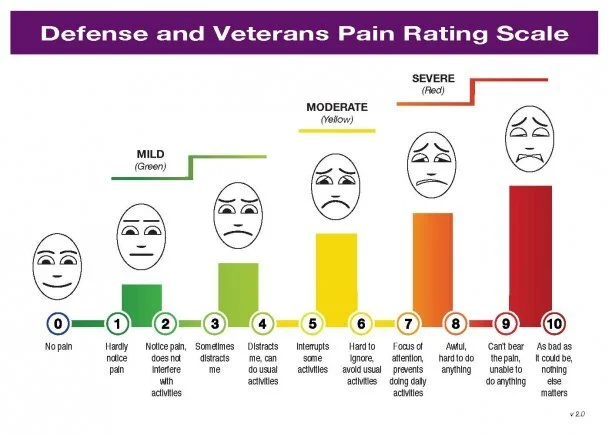Patient Assessment: The Key to Tracking Progress
When treating patients who suffer from pain, healthcare providers often use rating scales and other assessment tools to establish pain levels and monitor changes in activity and condition. These tools, though simple in form, enable providers to better understand pain severity and factors like duration, onset, type and impact on life. They are key to helping doctors make accurate diagnoses, create effective treatment plans and monitor the success of interventions.
What Type of Assessment is Best?
While numerous opinions suggest that no single pain scale is considered ideal for every situation, quantitative scales can be especially useful in assessing a patient’s response to treatment because they show whether the patient’s pain and activity levels have improved.
As noted by the Joint Commission, a non-profit organization that accredits healthcare programs across the U.S., the tools required to adequately assess pain may differ depending on a patient’s age, condition, his/her ability to understand and whether the pain is acute or chronic. Additionally, the timeframe for reassessment should be determined by the patient’s condition and goals of treatment.
Popular Tools Feature Scores, Images & Color
Examples of commonly used pain scales are the Numeric Rating Scale (NRS), which asks patients to score their pain on a scale of 1-10, or the FACES rating scale, which asks patients to choose from a series of faces with expressions ranging from neutral to severely distressed to depict their pain. While FACES is often used for children, it can also be beneficial with older adults and/or those with cognitive impairment.
The Veterans Health Administration (VHA) uses the Defense & Veterans Pain Rating Scale (DVPRS), which was developed by The Defense & Veterans Center for Integrative Pain Management. This assessment tool (see image below) utilizes a numerical rating scale, enhanced by functional word descriptors, color coding and pictorial facial expressions to evaluate pain levels. The numbers and “traffic light” color-coded bars delineate levels of pain: Mild (1-4, green), Moderate (5-6, yellow) and Severe (7-10, red).
Related Reading: Learn Why RS Medical Uses the DVPRS
Providers treating patients with chronic pain might use additional tools, like the McGill Pain Questionnaire (MPQ), to reveal specific sensory attributes of pain. There is also the Brief Pain Inventory (BPI) that enables patients to rate the severity of their pain and the degree to which it interferes with common dimensions of feeling and function.
Personalized Patient Assessments Go Further
Knowing how valuable quantitative tools can be to tracking pain levels and monitoring changes in a patient’s condition, RS Medical implemented Personalized Patient Assessments using the DVPRS.
Since the program’s inception in 2015, any patient prescribed an RS-4i Plus® has been queried to complete an initial, baseline survey establishing their pain levels and what impact pain has on their lives, activity levels and medication consumption before they begin treatment. Approximately 30 days into treatment, this is followed by a second survey – resulting in the ability to compare scores and document changes.
Questions featured in the RS Medical survey include a patient’s pain rating, as well as:
Activity: patients rate (on a scale of 1-10) how much pain interferes with their usual activities. Separately, they also rate how much muscle spasms affect their normal activities.
Sleep: patients rate how much pain interferes with their ability to sleep.
Mood: patients rate how much pain affects their mood.
Stress: patients rate how much pain contributes to their stress levels.
The assessment report shows both a graph and the numerical scores. For example, the results below show that this patient’s pain dropped by 6 points (or 75%) after using an RS-4i Plus for 30 days to treat back pain. There were also significant decreases in how pain affected his mood (50%), how it affected his stress level (62.5%) and how it interfered with his activity (62.5%).
Another section of the RS Medical report tracks any reductions in medication use reported by the patient, which in this case was that he was able to discontinue the use of all pain medication. He also noted that his pain relief lasted 8+ hours after taking a treatment.
Such detail is beneficial for both provider and patient. For the provider, it offers a multi-point talking tool to demonstrate whether pain levels are diminishing and/or whether specific qualities of life are improving. It can also highlight areas where a patient may need additional support.
For patients, the assessment serves as a progress report on his/her condition. It can sometimes be difficult to track changes on a day-to-day basis and having a written record can offer the necessary confirmation that improvement is possible.
Effective Treatment Begins with Accurate Assessments
While organizations and healthcare providers may differ on which tool(s) are best, there is widespread acknowledgement that the effective treatment of pain relies upon accurate and detailed assessments occurring at regular intervals – including re-assessment after pain relief interventions.
Those wanting additional reading, may consider reviewing these articles:
Providers, We Invite You to Learn More
If you’re a healthcare provider interested in learning more about the Personalized Patient Assessments that go with the RS-4i Plus, complete the form below and check the box to receive an assessment overview. Then judge for yourself how this remarkable device, which has helped over 21,000 patients nationwide, can work in your practice.
Related Resources
Blog: Chronic Pain in the VA, by the Numbers
Blog: Chronic Pain & Central Sensitization
This blog provides general information and discussion about medicine, health and related subjects. The words and other content provided in this blog, and in any linked materials, are not intended and should not be construed as medical advice. If the reader or any other person has a medical concern, he or she should consult with an appropriately-licensed physician or other healthcare professional.




